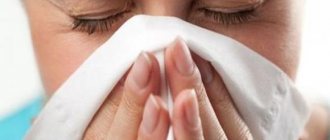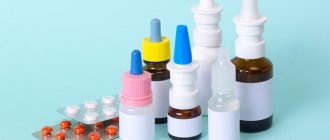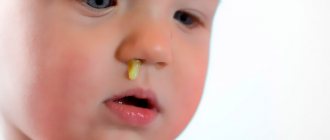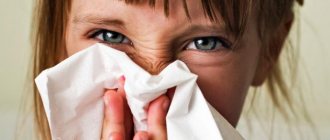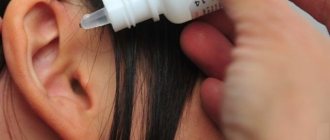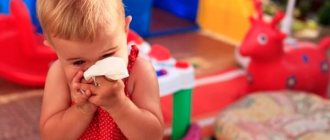Otolaryngologists quite often hear from their patients complaints about the sensation of a lump or accumulation of mucus in the nasopharynx. Patients are bothered by a sore throat, they have to constantly cough, but even a cough is not able to cope with the unpleasant, sometimes disgusting sensations.
As a result, people see no other option but to consult a doctor for help.
Medicine knows many reasons for mucus in the nasopharynx. When visiting a medical facility, the doctor will prescribe the patient a series of laboratory tests, an X-ray examination of the esophagus, an endoscopic examination of the stomach and esophagus, based on which he will determine the source of the pathogen and prescribe appropriate measures to eliminate the unpleasant sensation of mucus in the throat.
The most common causes of mucus accumulations are:
- viral diseases (ARVI, etc.);
- diseases of a bacterial nature (infection with staphylococcus, streptococcus, etc.);
- allergic reactions to pollen, dust, but more often to dairy products;
- pregnancy;
- taking certain medications;
- deviated nasal septum;
- postnasal drip, in which mucus, due to some reasons, flows into the throat from the nasopharynx;
- polyps in the nasopharynx;
- mouth breathing;
- Sjogren's syndrome, in which there is a decrease in the amount of saliva produced;
- Zenker's diverticulum, during which food accumulates in a special “pocket” of the esophagus;
- dehydration, etc.
“High temperature, stings the nasopharynx, mucus interferes with normal life” - the doctor also often hears these and other complaints from his patients. In this situation, it is important to find the real cause of the unpleasant symptom and relieve the person of discomfort.
How does mucus appear in the throat?
Epithelium is the top layer of cells that lines the pharynx. These cells tend to produce mucus, which is a viscous, transparent substance endowed with many useful functions. Constantly produced in the bronchi, trachea, nose, pharynx, mucus envelops these organs and protects them from drying out, prevents microbes and bacteria from penetrating into the body, is a unique habitat for some beneficial microorganisms, keeps the immune system in good shape, etc. . Why does there sometimes become a lot of discharge? When foreign bodies — microbes, allergens and other substances — enter the body, the respiratory system is instantly activated and begins to fight “uninvited guests.” The brain gives a signal to produce more mucus, and therefore, a person feels that the discharge literally envelops the nasopharynx, forms a lump in the throat and interferes with normal breathing.
Removing mucus from the nasopharynx
How to remove mucus from the nasopharynx when there is too much discharge and it disrupts a comfortable existence? First you need to establish the reason for the appearance of a large amount of mucus. This can only be done by an experienced doctor.
The most common methods of treating the patient are the following procedures:
- taking anti-inflammatory drugs, such as Strepsils, Septolete, Yox, etc.;
- taking antihistamines if the appearance of mucus is caused by an allergic reaction;
- taking antiseptic drugs;
- taking antibacterial agents, for example, IRS-19;
- taking homeopathic medicines, for example, Tonsilotren, Lymphomyosot;
- gargling;
- inhalation;
- drinking large amounts of liquid;
- exclusion of spicy, fatty, dairy products from the diet;
- steam treatment;
- avoid smoking, etc.
You can get rid of mucus in the nasopharynx using these effective methods, most of which give positive results after 1-2 uses. Often, complex treatment is used, which includes taking medications, rinsing, and inhalations. The effect of such treatment is achieved much faster than from using only rinses or just eliminating spicy foods.
Medicines should be taken only after they have been prescribed by a doctor. You should not self-medicate if the cause of the illness is unknown. Not only fast, but also high-quality help is important here.
Drug treatment
How to remove mucus from the nasopharynx? The process of evacuation of sputum from the respiratory tract can only be facilitated if its viscosity is reduced. For this purpose, secretolytic and secretomotor agents are used. You also need to take medications that help eliminate inflammation in the mucous membranes. This is the only way to reduce the activity of single-celled glands in the bronchi, trachea and nasal cavity, which produce an excessive amount of viscous secretion.
Mucolytics (secretolytic agents)
Mucolytic drugs reduce the amount of mucin in sputum, which has astringent properties. A decrease in the concentration of protein components in the mucus contributes to its liquefaction and detachment from the inner surface of the nasopharynx. With the help of secretolytic agents, not only sputum is removed from the respiratory system, but also purulent exudate, which is often formed during the development of sinusitis, purulent pharyngitis, tracheobronchitis, etc.
Mucolytic drugs can be used to treat adults and children over 3 years of age.
To transform a dry cough into a wet one, it is recommended to use:
- "Fluimucil";
- "ACC";
- "Ambroxol";
- "Mukopront."
Coughing up mucus allows you to clear the airways of pathological secretions and prevent the development of inflammation in the lower parts of the respiratory tract.
Expectorants (secretomotor agents)
Expectorant medications increase the sensitivity of cough receptors, thereby accelerating the process of removing mucus from the nasopharynx. During forced exhalation, pathological secretions containing pathogenic viruses or bacteria are evacuated from the lower and upper parts of the respiratory system. The best drugs with secretomotor action include:
- "Sinupret";
- "Ambrosan";
- "Tavilek";
- "Bromhexine."
Treatment with expectorants is indicated for the development of acute bronchitis, cystic fibrosis, tracheitis, bronchial asthma, etc.
Secretomotor drugs prevent mucus stagnation in the lower parts of the respiratory tract. If you do not start taking medications in time, this will lead to disruption of the drainage function of the bronchi and, as a result, the development of pneumonia.
Anti-inflammatory drugs
Local anti-inflammatory drugs can accelerate the regression of pathological processes directly at the sites of inflammation. Restoring the secretory activity of goblet cells will lead to a decrease in the amount of sputum in the respiratory tract. To ease the course of the disease and speed up the recovery process, it is recommended to use the following types of drugs:
Irrational use of drugs in the treatment of children is fraught with side effects - nausea, vomiting, diarrhea, urticaria, etc.
Treatment of children with aerosol preparations may provoke undesirable reactions. To prevent negative consequences, doctors recommend treating a sore throat with Lugol's Solution or antiseptic drugs.
How does mucus get into the throat?
Why does mucus drain from the nasopharynx into the throat? Otolaryngologists often hear this question from their patients. This often occurs in adults and children with rhinitis, a disease in which the source of inflammation is localized either in the far part of the nasal cavity or in the upper part of the pharynx itself.
When a person is in a supine position during sleep, the secretions formed precisely during posterior rhinitis flow into the throat, thereby irritating the mucous membranes of the pharynx and causing the person to cough.
Why is there snot?
Human snot consists of water, salt and the protein mucocin. The last component is responsible for the viscosity of nasal secretions. The color of the discharge can be called the main indicator by which it is easy to identify the stage of the disease and its type.
Thick, mucous snot may take on the following color:
- green;
- brown;
- yellow;
- transparent.
If the discharge is green, it will indicate a chronic illness. When the nose is clogged with such snot too often, the doctor will suspect pneumonia or chronic bronchitis.
To fight the virus, the immune system begins to produce a special substance that gives nasal mucus its color.
Yellow and brown snot usually occurs in experienced smokers. In such patients, nicotine enters the respiratory system, settles on the mucous membranes and stains the nasal mucus.
But sometimes yellow snot and thick discharge occur in a non-smoker. In this case, we are talking about the development of a serious disease, perhaps even oncology.
Washing and rinsing the nasopharynx with mucus
One of the most effective and fastest ways to get rid of mucus in the nasopharynx is rinsing. Before proceeding directly to rinsing, it is recommended to take a steam bath for your face. This procedure will make the mucus more liquid, and it will easily come out of the nasopharynx.
How to rinse the nasopharynx from mucus after such a bath? To prepare a bath, you can use a hot potato decoction or herbal decoctions - nettle, sage, young dill, mint, etc. It is necessary to slowly inhale such steam for 20 minutes, first through the nose, then through the mouth, then through the nose again.
After completing the procedure, you need to pour half a liter of warm water into the kettle and throw in coarse salt - about 2 tablespoons, dissolve it. Then you should put a regular baby pacifier on the spout of the kettle, in which a hole with a diameter of 4-5 mm is made. This will protect the nasopharyngeal mucosa from possible burns.
To rinse, you need to bend over a sink or bathtub, insert a pacifier into the nostril that is freer from mucus and start pouring saline solution into it. The head should be slightly tilted to one side so that the solution can pour out of the other nostril. During the procedure you need to breathe through your mouth. If water gets into your mouth, you should lean forward. After rinsing one nostril, you need to blow your nose well and then proceed to rinse the other nostril.
If there is mucus in the nasopharynx, how to get rid of it
from it by rinsing? It’s very simple: you need to take a little saline solution into your mouth (the proportions are the same as for rinsing), gargle for 20 seconds and spit out the liquid. Repeat the procedure about 15-20 times in the morning and evening after brushing your teeth.
You should not ignore such a seemingly insignificant symptom as the abundant appearance of mucus. It is necessary to seek qualified help from a doctor who will prescribe appropriate treatment and relieve discomfort.
The mucus in the nasopharynx is an excellent nutrient source for various types of microorganisms. Typically, proteins composed of amino acids may contain sulfur components. And if a person feels an excess amount of mucus (and the urge to cough up) in the nasopharynx, then this is an excellent environment for bacteria to live and multiply. Accumulating mucus in the nasopharynx envelops the nasal cavity and the root of the tongue. It consists of proteins, and this is an excellent food for anaerobic bacteria.
Unpleasant smell
The accumulation of a pathogenic environment is the main cause of bad odor from the mouth, be it mucus in the nasopharynx in children or adults. Its appearance is also possible with sore throat and colds. Studies have shown that a large amount of mucus and sputum that accumulates in the nasopharynx, when in contact with bacteria, behaves like a fuel cell. Many people believe that bad odor does not come from the mouth, but from the nasal cavity itself. But it is the mouth and throat that are the source of the bad odor, and the mucus that regularly accumulates in the nasopharynx only worsens the situation, promoting the proliferation of even more bacteria.
Related measures
To reduce mucus secretion, you need to provide the body with foods high in vitamins C and E. Breathing exercises also help reduce the number of bacteria. You should drink a lot of water (about eight glasses a day), use salt rinsing, and do inhalations with the addition of eucalyptus oil. As far as possible, contact with cigarette smoke and household chemicals should be avoided. It is recommended to install air humidifiers indoors; such manipulations will help make the mucus in the nasopharynx more liquid.
The human nasopharynx is covered with a thin layer of natural mucus, which protects the walls of the larynx, throat and nasal passages from drying out. Also, this sputum has a beneficial effect on the microflora of the respiratory tract. However, there are times when the amount increases, its exit becomes difficult and it accumulates in the nasopharynx.
This phenomenon is very unpleasant and causes some discomfort. A person feels a sore throat, a burning or tickling sensation in the nose, and an irresistible urge to cough up accumulated mucus. It becomes more difficult to breathe and speak because the mucus stagnates and causes discomfort.
In a wet environment, bacteria and harmful microorganisms can develop, which can cause certain diseases of the respiratory tract or digestive system (with frequent ingestion of accumulated mucus).
In addition, excess mucus is often the cause. If you do not pay attention to the stagnation of mucus in time and do not start timely treatment, you can start the problem and then the consequences can be more severe.
How to get rid of mucus in the nasopharynx at home and how to prevent its occurrence in the future - we will tell you about this in this article.
Traditional treatment
The question of how to get rid of mucus in the nasopharynx in cases accompanied by a purulent inflammatory process is decided by an otolaryngologist. A medical professional may propose a treatment regimen that includes the following:
- antibiotics (cephalosporins);
- drugs that thin sputum and facilitate its drainage (bromhexine, ambrobene, ACC, lazolvan);
- gargling with antiseptic solutions (miramistin, chlorhexidine, furatsilin);
- nasal rinsing (cuckoo procedure);
- antihistamines (suprastin, loratadine);
- immunomodulators;
- physiotherapy in a clinic setting.
Causes of mucus accumulation in the nasopharynx
A certain amount of mucus is present in the nasopharynx - and this is the norm. However, if the body produces an excessive amount of mucus, then in this way it tries to protect itself from external irritants. We need to find out what causes the appearance of mucus in the nasopharynx and how they manifest themselves.
I especially want to get rid of mucus in the nasopharynx in the morning, when phlegm has accumulated overnight and cannot be released. To alleviate your condition, you can rinse your nose with salt water and gargle. If the condition is not advanced, then these easy techniques can help you get rid of mucus in the nasopharynx.
Important:
if accumulated mucus bothers you in the morning for several days, go see an ENT specialist - this could be a sign of pharyngitis.
Causes of mucus accumulation
Mucus in the nasopharynx is a pathological process caused by various factors:
- acute or chronic respiratory infection (rhinitis, sinusitis, sinusitis, adenoiditis, mononucleosis, pharyngitis);
- allergic reactions to impurities in the air (dust, tobacco smoke, wool, pollen, mold);
- bronchial asthma;
- vasomotor rhinitis due to uncontrolled use of vasoconstrictor drops;
- smoking;
- hormonal changes, for example during pregnancy.
How to get rid of mucus in the nasopharynx - simple and effective treatment methods
To prevent the accumulation of mucus in the nasopharynx, first of all, you need to identify the root cause of its occurrence. Having determined the source of the sputum, you can develop a treatment plan for this problem. If the accumulation of mucus in the nasopharynx is allergic or painful in nature, drug treatment cannot be avoided.
All medications must be prescribed by a professional physician.
In case of illness or irregular accumulation of mucus in the nasopharynx, you can use home treatment methods, which are no less effective!
If you want to get rid of a lump in your throat, you need to drink as much fluid as possible! Purified water, fruit juices or herbal infusions must be lukewarm to make them pleasant to drink. Cold liquid can cause a cold in the throat, which can lead to inflammation. Hot drinking is also contraindicated - you can burn the mucous membrane.
To remove sputum, an ordinary solution of salt + soda + iodine is often used. By the way, this “liquid” can be used for various throat diseases. The recipe is very affordable, and also quite effective. For a glass of hot water, a teaspoon of any salt (ideally sea salt) and soda, a few drops of iodine. Stir until completely dissolved and you can rinse. The main thing is that the solution is a pleasant temperature for the throat - it does not burn and is not cold. Together, these components disinfect, liquefy mucus and remove it from the nasopharynx.
In this case, gargling with herbs helps a lot. For rinsing, you can use inexpensive pharmaceutical herbs - calendula or chamomile. For a teaspoon of herbs (can be used individually or mixed), take a glass of boiling water, pour it in and let it brew. Rinse every 3-4 hours between meals. Chamomile removes inflammation and removes phlegm from the body well, and calendula is an excellent antibacterial and healing agent.
For complex treatment, you need to rinse your nose 3-4 times a day. To rinse your nose, use boiled water at about 30 degrees. A solution that removes mucus well and moisturizes the mucous membrane is a glass of water and 10 ml of eucalyptus oil. In addition, it heals small wounds well. After rinsing, you can drip your nose with aloe juice or onion juice diluted with water. You need to monitor how your body reacts to such treatment. At the slightest sign of an allergic reaction, consult a doctor immediately!
Home treatment methods are productive and more gentle than medication. Their main disadvantage is that they take a little longer to get rid of mucus. If after 3-4 days none of the described methods help or another symptom is added - fever or sore throat, you need to visit the clinic and find out the cause of the disease.
How to thin a child’s snot, means and methods
In the treatment of inflammatory processes in the upper respiratory tract, snot thinners play a significant role. The choice of drugs is based on the etiology of the disease, severity and nature of the discharge produced. Secretomotor therapy is aimed at reducing the viscosity of nasal mucus and improving its outflow.
Poorly discharged nasal secretions act as catalysts for an unproductive cough, disruption of natural breathing, and the development of a chronic form of pathology and sinusitis. The doctor’s task is to identify and eliminate the source of the lesion, alleviate symptoms, and thin snot in adults and children. Positive dynamics can be achieved with the help of pharmaceutical products and traditional medicine recipes.
Under favorable conditions, the body produces transparent mucus to moisturize the epithelium and protect against the penetration of pathogenic strains, antigens, and dust. The composition of muconasal secretion is represented by three main components: salt, water and mucin protein.
Under the influence of aggressive external and internal factors, active production of mucoproteins occurs, which are responsible for the concentration of snot.
The appearance of naturally colored, odorless mucus is associated with respiratory diseases, allergic reactions, and anatomical disorders. A change in color to a yellow or green tint indicates a bacterial etiology, a chronic form of rhinitis.
Thick green snot precedes recovery and indicates the death of leukocytes and pathogenic bacteria.
Interesting! With systematic abuse of tobacco products, nicotine tars settle on the inner membranes, turning the muconosal secretion brown.
The causes of viscosity include unfavorable indoor climate conditions, hypothermia, untimely or incorrect medical care.
Blowing your nose will not solve the problem of sticky mucus; an integrated approach is needed here. Treatment for thick snot begins with a visit to the doctor. Based on a visual examination and endoscopic examination, the doctor determines the nature of rhinitis and draws up a therapeutic regimen.
Mechanical cleansing of the nasal passages
You can thin thick snot with a saline solution. It is prepared at home: 250 ml. add 15 g of table salt to water, stir until the crystals are completely dissolved.
Irrigation of inflamed tissue should be carried out in a horizontal position, with the head tilted at an angle of 90°. Using a syringe without a needle or a medical bulb, the solution is injected into each nostril one by one. If the irrigation technique is followed, the remaining fluid flows freely through the opposite nasal canal.
Such hygiene procedures are allowed for adults and children over 4 years of age.
For patients under 3 years of age, a low concentration saline solution is used for instillation. 2-3 drops are carefully introduced into each nasal passage every 4 hours until complete recovery. At the end of the procedure, any remaining mucus is removed using aspirators, cotton swabs, or blowing your nose.
Important! The use of a saturated saline solution is fraught with drying out of the mucous membrane and the formation of crusts on the surface, which, when deformed, manifest as nosebleeds.
The line of pharmaceutical moisturizers is represented by Aquamaris, Salin, Aqualor, and the Dolphin system.
Salts and crystals of ocean water gently cleanse, saturate the epithelium with water, reduce swelling, and cleanse the sinuses of foreign agents. Medicinal sprays do not cause tachyphylaxis (addiction to medications), therefore they are used for an unlimited course.
What drops thin snot?
Drugs of the secretomotor group are designed to normalize breathing, facilitate the outflow of mucus, and relieve inflammation and swelling.
The composition of medicinal products is represented by herbal components and synthetic compounds that restore drainage function and activate the mucociliary apparatus.
For reference! The liquefying activity is provided by essential oils of eucalyptus, fir, anise, elderberry, marshmallow root, thyme, and primrose.
Mucolytic and secretolytic drugs provoke contraction of the bronchial muscles, increase the activity of the ciliated epithelium, and clear the nasal passages of mucus accumulation. They influence the rheological properties of muconasal secretion without increasing its volume.
The action of enzymes (trypsin, chymotrypsin) and chemicals (acetylcysteine, ambroxol) is aimed at normalizing the ratio of serous and mucous discharge, increasing the concentration of surfactant (an active substance that prevents the gluing of villi of the ciliated epithelium, promotes the removal of sputum).
Rinofluimucil
Rinofluimucil is an effective nasal drop that thins mucus. Under the influence of acetylcysteine, the viscosity of the secretion of the bronchial glands decreases, free sputum separation occurs, and an expectorant effect occurs.
Tuaminoheptane sulfate exhibits vasoconstrictor activity and eliminates hyperemia of the inner membrane.
The nasal cavity is irrigated with an aerosol, 2 doses into each opening at equal intervals up to 4 times a day. The children's norm is limited to one click three times a day, no more than 7 days.
The drug is prescribed to patients over 2 years of age. The advisability of using nasal drops during pregnancy and breastfeeding is determined by the doctor.
Sinuforte
Sinuforte has become widespread in ENT practice. A medicinal liquid of plant origin (based on cyclamen extract and juice) stimulates a reflex reaction, which is manifested by mucous secretions.
The result of dehydration is the normalization of the viscosity of the exudate, the creation of favorable conditions for the removal of serous discharge, and the improvement of ventilation of the paranasal sinuses.
The medication does not have an irritating effect. An exception would be increased sensitivity of the body to individual components.
Prescribed for adults and children over 12 years of age, 2-3 drops once for 6-8 days. The duration of the course increases to 15 days if nasal drops are prescribed every other day.
Antiviral drugs
When the cause of thick snot is a bacterial form of rhinitis, it is advisable to use pharmaceutical products based on interferon or polypeptide.
The active substances are active at the intercellular level and are effective in the initial stages of mucosal inflammation or for preventive purposes.
Intranasal preparations have antiviral activity:
Medicines are included in the therapeutic regimen of children from the first days of life. Indications for use include infection of the upper respiratory tract, inflammation of the paranasal sinuses, acute respiratory viral infections, and preventing the risk of pneumonia.
The course and dosage is determined by the doctor, taking into account the physiological characteristics and medical history of the patient. It is not recommended to use the drug for longer than 5 days.
For reference! One of the oldest and most reliable antiviral agents is “Oxolinic ointment”. For therapeutic and preventive measures, the mucous membrane is treated with a thick substance 3-4 times a day.
Antihistamines for sticky snot
The release of thick white mucus is interpreted as a protest from the body to the presence of allergens. Potent antigens include:
- plant spores;
- household chemicals;
- pet hair;
- dust;
- tobacco smoke;
- harmful production conditions.
Combined antihistamine drops have a complex effect on the body: “Sanorin”, “Analergin”, “Alergodil S”, “Vibrocil”.
The group of sympathomimetics has a vasoconstrictor effect, normalizes blood flow to the mucous membrane, and blocks the actions of histamine H₁ receptors.
Patients with pathologies of the cardiovascular system, metabolic disorders, and blood pressure are recommended to limit contact with nasal medications. For children over 3 years old, instill 1 drop alternately every 4 hours, for adults 2-3 drops at the same frequency.
Inhalations
Thinning nasal drops for children are more effective when the medication is administered through a liquid spray. The procedure helps improve mucus discharge, restore nasal drainage, and reduce swelling.
You can carry out manipulations at home if you have a special device - an inhaler. The operating principle of the nebulizer is based on fine spraying. The therapeutic effect occurs faster than when using nasal sprays and allows you to treat the maximum area of the nasal cavity.
Nuance! It is recommended to inhale an hour before or after meals.
For a thick runny nose, use alkaline mineral waters “Borjomi”, “Essentuki”, “Narzan”. A cheaper, but no less effective option is saline solution.
Lazolvan, Fluimucil, Ambrobene, and ACC Inject are effective in treating the respiratory tract and liquefying sputum.
How and how to thin a child’s snot using folk remedies
Alternative medicine is used in combination with conservative methods. The essence of folk recipes is the formation of immune protection, epithelization of soft tissues, and a decrease in the viscosity of sputum.
The following manipulations can improve the discharge of adhesive secretions:
- Irrigation of the nasal sinuses with garlic or onion juice. The garden plant is crushed to a pasty state, the juice is filtered through cheesecloth, diluted with water in a ratio of 1:3. To improve the therapeutic effect, add an incomplete teaspoon of honey. Place 1-2 drops in each nostril for 10 days;
- aloe/kalanchoe. The nasal canals are irrigated alternately with freshly squeezed juice three times a day until complete recovery;
- cleansing the paranasal sinuses with herbal decoctions. A medicinal liquid is prepared from one component or a combination of several (chamomile, calendula, sage, coltsfoot);
- steam heating of the lower and upper extremities with the addition of eucalyptus oil or dry mustard powder. The procedure is performed at natural body temperature.
Moist air is a concomitant factor for rapid recovery. To normalize a favorable microclimate, it is necessary to ventilate the room every day, use a humidifier (as an alternative to hanging wet towels), especially during the heating season.
When the air humidity reaches 55-60%, the task is solved.
The thick consistency of viscous secretion indicates pathological changes in the body and requires medical attention. Inaction in case of an ENT disease is fraught with the development of a chronic form of damage, otitis, and inflammation of the cerebral cortex.
Adults should know what thins snot, which pharmaceutical products are more effective and safer. However, in order not to harm your health or your child, therapeutic manipulations must be carried out according to the instructions of the doctor.
Directory of main ENT diseases and their treatment
All information on the site is for informational purposes only and does not claim to be absolutely accurate from a medical point of view. Treatment must be carried out by a qualified doctor. By self-medicating you can harm yourself!
Materials: https://gorlonos.com/nos/chto-razzhizhaet-sopli.html
How to get rid of mucus in the nasopharynx after ARVI
If the cause of mucus is a cold or a viral disease, then you can get rid of mucus in the nasopharynx at home. It is recommended to drink more warm tea or milk. Drinking helps remove toxins from the body and washes away excess mucus.
Remember that the drink must be warm! Hot liquid can cause great harm to inflamed mucous membranes
.
Rinsing the nose and gargling, steam inhalations also help very well to get rid of mucus in the nasopharynx using folk remedies.
Take internally
Inhalations
If after a couple of days home treatments do not bring improvement, you should consult a doctor. You may have sinusitis - inflammation of the maxillary sinuses, in which mucus flows down the walls of the nasopharynx and stagnates. By curing sinusitis, you will get rid of phlegm.
How to help yourself with excess mucus in the nasopharynx?
Even if no one tries to get out of visiting a doctor, then before going to the clinic you need to somehow alleviate your condition. Since there is no diagnosis yet and it is not yet possible to treat the cause, it is necessary to influence the symptoms in order to somehow alleviate them. What can I recommend here?
Firstly, inhalations (with potatoes, soda, herbs), and secondly, rinsing the nasopharynx with saline solution. Regarding herbal decoctions and infusions, we can say the following: herbs can be very powerful remedies, so it is better to refrain from using herbs for treatment until a diagnosis is made. Unless you can make a chamomile infusion.
Sometimes it is advised to rinse the nasal cavity with laundry soap, drip beet or carrot juice into the nose, drip with onion or garlic juice... But it would be better to wait with any instillation until a diagnosis is made. Tell me, why injure the nasopharyngeal mucosa with onion juice if it turns out that it is allergic rhinitis? So, before visiting a doctor, it is better to limit yourself to simply washing with saline solution. In any case, it is better not to postpone visiting the clinic.
Among other things, in this condition you need to drink more - warm water, warm compote or fruit drink, heated (at least not cold) natural juices, to which you are definitely not allergic, weak sai with lemon. Please note: the drink should be warm, but not hot, since hot liquid can further injure the already inflamed mucous membrane of the pharynx.
You don’t need to drink a large mug of liquid at once, it’s better to take a few sips, but more often.
How to get rid of mucus in a child's nasopharynx
Quite often, mothers of babies can observe such a problem as the accumulation of mucus in the nasopharynx. Of course, this phenomenon worries mothers and therefore they turn to the pediatrician with the question “How to get rid of mucus in a child’s nasopharynx? How serious is this and what home treatment methods are there?”
In fact, without a proper examination, the pediatrician will not be able to determine the reason for the appearance of mucus in the baby’s nasopharynx, since there may be several reasons for the appearance of this “nasty”. Let's look at this problem in more detail.
How to get rid of mucus in the nasopharynx of a baby
Little people are more susceptible to the problem of mucus in the nasopharynx than others. The main reason is the immaturity of the nasal passages - they are very narrow, the nose and cartilages are also poorly formed, the vessels are very thin and cannot cope with the job of heating the air when inhaled. Dust, dry air, coolness - all this can provoke the appearance of mucus in the nasopharynx of a newborn baby. Since the baby is not yet able to explain what is bothering him, parents should monitor the temperature in the room, the level of humidity and the cleanliness of the room.
A fairly common cause of mucus accumulation in the nasopharynx in infants is teething. At this time, the baby’s body weakens, devotes all its strength to the appearance of a tooth, and then the mucous membrane reacts to various irritants by increasing the amount of sputum in the nasopharynx.
To get rid of mucus in the nasopharynx of a baby, you need to rinse the nose with a saline solution as often as possible. Pharmacies sell ready-made sea salt solutions - Aqualor, Humer or Otrivin. The prices for them vary, but with frequent use it is much easier and cheaper to prepare the saline solution yourself.
Sea salt can be found in any supermarket. For 1 glass of chilled boiled water, take 1 teaspoon of salt and stir well. Rinse the baby’s nose with the resulting solution as often as possible. Salt water not only removes mucus, but also has a certain disinfecting effect on the nasopharynx.
You can also use an aspirator to help your baby get rid of mucus in the nasopharynx. This is a special device that allows you to suck out mucus or snot from your baby. The nasal aspirator must be used with caution so as not to damage the baby's mucous membranes. Pediatricians recommend using this device as little as possible.
To help your baby get rid of mucus in his nose, you need to twist a cotton wool flagellum and clean your baby's nose in a circular motion. This way you can remove at least a little mucus from the nasal passages and make it easier for your baby to breathe.
To get rid of mucus in the nasopharynx of a 2-year-old child, you also need to rinse the nose with salted water. You can add inhalation with a nebulizer from herbal decoctions or physical solution to the rinsing. Thanks to this device, the effect of the drugs reaches the destination site faster - in our case, the nasopharynx.
Boiled potatoes in their skins with the addition of a teaspoon of soda as an inhalation can also help the baby get rid of unpleasant mucus.
Warm milk with honey, which you should drink at night, is a good expectorant. In addition, it will be useful for the child to drink this wonderful drink.
To clear mucus from the airways, you can try giving your child thyme tea. Place a dessert spoon of thyme seeds in 1 cup of boiling water and let it brew for 15-20 minutes. Give half a glass in the morning and evening. After 3-4 days, an improvement will occur, the accumulated mucus will begin to move away from the nasopharynx and it will become a little easier to breathe and swallow. Do not exceed treatment for 10 days.
Remember: drinking plenty of fluids will help remove mucus from the nasopharynx.
How to get rid of mucus in the nasopharynx during pregnancy
Often, at an appointment with an obstetrician-gynecologist, pregnant women talk about the problem of mucus accumulation in the nasopharynx. This phlegm causes discomfort to expectant mothers, especially in the morning hours. A lump in the throat, soreness, dryness and pressure on the walls of the larynx - all these symptoms can haunt a woman at any time during her pregnancy.
Pregnant women try to cough up this mucus, but quite often the mucus can come out with blood clots. The phenomenon itself is not dangerous; it is the thin vessels in the nasopharynx bursting due to overstrain. However, we should not forget about this problem.
You cannot self-medicate while pregnant.
At first glance, harmless or decoctions for gargling can harm the expectant mother. Sage, celandine, calendula, clover and aloe can cause increased uterine tone, which can lead to miscarriage. Therefore, it is better to coordinate any of your actions on how to get rid of mucus at home with your doctor.
To get rid of mucus in the nasopharynx during pregnancy, you need:
- remove fried and salty foods from your diet;
- drink more fluids - fresh juices, fruit drinks, green tea;
- gargle with sea salt (at the rate of a teaspoon per glass of water) or propolis tincture (1 small spoon of tincture per 200 ml of warm water) - these solutions are harmless even for a pregnant woman and can be used 4-5 times a day;
- consume vitamin C in large doses to maintain immunity;
- use of medications only as prescribed by a doctor.
Inhalation over boiled potatoes can also help get rid of mucus during pregnancy. This treatment method is suitable even for children, as it is safe and does not cause side effects.
Nasopharyngeal diseases are one of the most common diseases
.
The throat burns, itches, a dry, painful cough appears, the nose gets stuffy, and mucus accumulates.
How to cure this trouble? Is treating nasopharynx at home effective?
What diseases of the nasopharynx bother you most often?
More about the nasopharynx
The pharynx is divided into several parts:
- Nasopharynx
. This is the upper part of the throat, located next to the first and second cervical vertebrae. The mucous membrane is covered with ciliated epithelial tissue, which ensures the removal of pathogenic particles from the nasopharynx. Without the structural features of the nasopharynx, a person would not be able to live even a few days: pathogenic particles would easily penetrate into his lungs. - The oropharynx
is the middle section of the throat, located below the nasopharynx. Includes the soft palate, base of the tongue, tonsils, and posterior wall of the pharynx. Ends with the superior epiglottis. - The laryngeal part (lower section)
begins at the level of the epiglottis and ends at the entrance to the esophagus.
The structure of the pharyngeal mucosa includes a huge number of nerves. Minor inflammations in the throat cause discomfort in the throat, dryness, soreness, and a feeling of a foreign body in the throat.
Nasopharyngeal diseases have similar symptoms:
If you have similar symptoms, you should consult a doctor. Due to the lack of adequate treatment, the course of the disease can become chronic.
The intensity of symptoms depends on the form and stage of the disease. Specific symptoms:
- in case of acute rhinitis, it is necessary to be treated for 12 days, after which the nasal discharge will disappear;
- catarrhal runny nose is characterized by mild manifestations, but the patient’s general condition will be poor;
- polyps impair sleep; if they are present, the ears become blocked;
- with ozena disease, nasal discharge has a greenish tint with a rotten smell;
- sinusitis provokes a prolonged runny nose, sputum discharge will be difficult;
- frontal sinusitis affects only one part of the nasopharynx, but is manifested by migraine attacks and pain in the nasal sinuses;
- with scleroma, infiltrates appear that look like flat or lumpy elevations.
Diseases of the nasopharynx also include the following diseases:
- laryngitis;
- pharyngitis;
- tonsillitis;
- retropharyngeal abscess;
- parapharyngeal abscess;
- adenoid hypertrophy;
- paratonsillitis;
- injuries and wounds of the pharynx.
The formation of the disease is influenced by the following factors:
- Systematic consumption of cold food and drinks.
- Hypothermia.
- Overstrain of the vocal cords.
- Viruses, fungi, pathogenic microorganisms.
- Injuries in the throat area.
- Sore throats.
- Thyroid diseases.
A fairly common disease is nasopharyngitis, inflammation of the nasopharynx.
Let's look at the symptoms and treatment of inflammation of the nasopharynx. This is a viral infection that affects the mucous membranes of the nose and throat. Includes signs of pharyngitis (acute pain and burning throat when swallowing) and rhinitis (nasal congestion, runny nose, headache).
The nose is washed with saline solution and vasoconstrictor drops and sprays are applied. Swelling of the pharynx is relieved with Lugol's and Yox's solution.
Such a seemingly harmless symptom as drying out of the nasopharynx can lead to various complications: at first it becomes difficult to breathe, then a stuffy nose, loss of smell, children begin to cough, snore at night, frequent headaches, dry crust in the nose, cracks on the mucous membrane.
The protective properties of the nose weaken, which becomes the cause of frequent infectious or viral diseases.
What are the causes and treatment of dry nasopharynx? Causes:
- reaction to long-term use of nasal drops;
- dry indoor air;
- constant breathing through the mouth due to nasal congestion;
- congenital curvature of the nose;
- mechanical damage;
- overstrain of the vocal cords.
How to moisturize the nasopharynx?
Dryness in the nasopharynx is treated with vasoconstrictors, moisturized with light saline solutions or special preparations (Aquamaris, Aqualor). The problem of dry air is solved with the help of humidifiers.
If your nasopharynx hurts, how to treat it?
Treatment
Usually, nasopharyngeal diseases are treated with conservative methods. Therapy depends on the manifestation of the disease:
- Elevated body temperature is treated with antipyretic drugs, and bed rest is required.
- To get rid of a cough, the doctor prescribes mucolytics to speed up recovery.
- If sputum is produced, vasoconstrictors are taken.
In case of ozena disease, surgical treatment may be required to remove pathogenic crusts, purulent accumulations, and eliminate dry nasopharynx.
For sinusitis, take the following medications:
- vasoconstrictors to reduce swelling (Naphthyzin, Galazolin);
- antibiotics (Amoxicillin, Amoxiclav);
- moisturizing drops (Rinolux, Aqualor);
- aerosol inhalation.
To clear the nasopharynx of mucus, rinse the nose and gargle
.
How to remove mucus? First, make a steam bath for your face. It thins mucus and promotes its rapid removal.
For the bath, use a hot decoction of potatoes and sage, mint, ground dill or nettle herbs. These ingredients are poured with boiling water, and the steam is slowly inhaled through the nose and mouth alternately for several minutes.
Rinse the nose with saline solution or Aqualor containing isotonic natural sea water.
How to remove snot using this product? Aqualor is able to rinse all parts of the nasal cavity, clean them of bacteria, viruses, crusts, mucus, contaminants, moisturizes, increases local immunity, accelerates the regeneration of the nasal mucosa, and increases the therapeutic effectiveness of medications that are applied to the nasal mucosa.
It rinses the nose well for both adults and small children. Apply to each nasal passage 4 times a day.
How to rinse correctly?
Bend over the bathtub or sink, insert the dispenser into the nostril that breathes better, and gradually begin pouring the solution into it, turning your head slightly to the side. After rinsing, blow your nose thoroughly and rinse the other nostril.
The child is placed on his side. Inject a small stream of 2.5 ml of saline solution into one nasal passage through a syringe without a needle. Turn the baby's head in the other direction and rinse the second nasal passage.
The baby's head should not be tilted back
. If he chokes, he is placed on his stomach and lightly tapped between his shoulder blades.
Do not inject the solution quickly and under high pressure
. The fluid will enter the Eustachian tube and provoke the development of otitis media. The syringe can be replaced with a pipette.
The mucus is removed using an aspirator. Using cotton wool soaked in oil, clean the child's nose from crusts. After cleansing, the medicine prescribed by the pediatrician is instilled (Nazivin 0.01% or Nazol baby). Drops are used no more than once every six hours.
How to thin snot?
Antihistamines or special cold medications will help reduce discharge.
It is necessary to frequently ventilate the premises or do wet cleaning. Moist air dilutes snot well. The patient should blow his nose more often.
How to relieve swelling?
More often, infectious swelling of the nasopharynx appears - nasopharyngitis. The causative agents of the disease are viruses and bacteria. A weakened immune system is unable to cope with pathogenic microorganisms. Often progresses to sinusitis.
Symptoms:
- the throat is sore, dry;
- watery discharge forms in the nose;
- the face swells, the ears are blocked;
- headache;
- Often only one side of the face hurts.
Treat the disease with vasoconstrictor drugs, for example, Xylometazoline
. A light massage of the bridge of the nose will help. It is also smeared with a warming ointment (for example, Zvezdochka).
The throat is gargled with herbal decoctions, the nose is washed with Aqualor or a saline solution.
For acute sinusitis with elevated body temperature and severe sore throat, antiviral drugs (Oseltamivir) and antibiotics (Amoxicillin) are prescribed.
For purulent sinusitis, a puncture is performed: the area above the nasolabial triangle is pierced under the inferior turbinate, and the sinus cavities are washed with antiseptics.
For allergic swelling of the nasopharynx, Suprastin and Loratadine are prescribed.
The following drugs will help cure the disease:
How to get rid of phlegm?
There are many remedies that clear the throat of mucus. Rinse is delivered to the infectious focus, destroys microorganisms, reduces inflammation, and stimulates mucosal regeneration.
Pus, microbes, and their waste products are removed. The rinse solution should be warm. Gargle up to 6 times a day for several minutes.
Rinse aids:
Recipes:
Prevention
Before using any of the above remedies, you must obtain a doctor’s permission.
The mucous membrane of the nose and the surrounding paranasal sinuses is normally covered with mucus secreted by special glands. It is necessary to humidify the inhaled air and cleanse it of dust. Nasal mucus also has an antiseptic effect, preventing the proliferation of harmful microorganisms. Its main components are water, mucin (a gel-like substance), salt and epithelial cells.
Drugs that thin the mucus in the nose
an integrated approach is needed here . Treatment for thick snot begins with a visit to the doctor. Based on a visual examination and endoscopic examination, the doctor determines the nature of rhinitis and draws up a therapeutic regimen.
Mechanical cleansing of the nasal passages
You can thin thick snot with a saline solution. It is prepared at home: 250 ml . add 15 g of table salt , stir until the crystals are completely dissolved.
Irrigation of inflamed tissue should be carried out in a horizontal position, with the head tilted at an angle of 90° . Using a syringe without a needle or a medical bulb, the solution is injected into each nostril one by one. If the irrigation technique is followed, the remaining fluid flows freely through the opposite nasal canal.
Such hygiene procedures are allowed to be carried out by adults and children over 4 years of age .
For patients under 3 years of age, a low concentration saline solution is used for instillation. are carefully introduced into each nasal passage every 4 hours until complete recovery. At the end of the procedure, any remaining mucus is removed using aspirators, cotton swabs, or blowing your nose.
Important! The use of a saturated saline solution is fraught with drying out of the mucous membrane and the formation of crusts on the surface, which, when deformed, manifest as nosebleeds.
The line of pharmaceutical moisturizers is represented by Aquamaris, Salin, Aqualor, and the Dolphin system.
Salts and crystals of ocean water gently cleanse, saturate the epithelium with water, reduce swelling, and cleanse the sinuses of foreign agents. Medicinal sprays do not cause tachyphylaxis (addiction to medications), therefore they are used for an unlimited course.
The danger of blowing sticky snot is explained by the risk of damage to the eardrum, which is located at the junction of the nasal cavity with the middle ear.
What drops thin snot?
Drugs of the secretomotor group are designed to normalize breathing, facilitate the outflow of mucus, and relieve inflammation and swelling .
The composition of medicinal products is represented by herbal components and synthetic compounds that restore drainage function and activate the mucociliary apparatus.
For reference! The liquefying activity is provided by essential oils of eucalyptus, fir, anise, elderberry, marshmallow root, thyme, and primrose.
Mucolytic and secretolytic drugs provoke contraction of bronchial muscles , increase the activity of the ciliated epithelium, and clear the nasal passages of mucus accumulation. They influence the rheological properties of muconasal secretion without increasing its volume.
The action of enzymes (trypsin, chymotrypsin) and chemicals (acetylcysteine, ambroxol) is aimed at normalizing the ratio of serous and mucous discharge, increasing the concentration of surfactant (an active substance that prevents the gluing of villi of the ciliated epithelium, promotes the removal of sputum).
Rinofluimucil
Rinofluimucil is an effective nasal drop that thins mucus Under the influence of acetylcysteine, the viscosity of the secretion of the bronchial glands decreases, free sputum separation occurs, and an expectorant effect occurs.
Tuaminoheptane sulfate exhibits vasoconstrictor activity and eliminates hyperemia of the inner membrane.
The nasal cavity is irrigated with an aerosol, 2 doses into each opening at equal intervals up to 4 times a day . The children's norm is limited to one click three times a day, no more than 7 days .
The drug is prescribed to patients over 2 years of age . The advisability of using nasal drops during pregnancy and breastfeeding is determined by the doctor.
Sinuforte
Sinuforte has become widespread in ENT practice . A medicinal liquid of plant origin (based on cyclamen extract and juice) stimulates a reflex reaction, which is manifested by mucous secretions.
The result of dehydration is the normalization of the viscosity of the exudate, the creation of favorable conditions for the removal of serous discharge, and the improvement of ventilation of the paranasal sinuses.
The medication does not have an irritating effect . An exception would be increased sensitivity of the body to individual components.
Prescribed for adults and children over 12 years old, 2-3 drops once for 6-8 days . The duration of the course increases to 15 days if nasal drops are prescribed every other day.
Mucin protein is responsible for increasing the concentration of snot
Antiviral drugs
When the cause of thick snot is a bacterial form of rhinitis, it is advisable to use pharmaceutical products based on interferon or polypeptide.
The active substances are active at the intercellular level and are effective in the initial stages of mucosal inflammation or for preventive purposes.
Intranasal preparations have antiviral activity:
- "Genferon";
- "Grippferon";
- "Laferon";
- "Nazoferon".
Medicines are included in the therapeutic regimen of children from the first days of life . Indications for use include infection of the upper respiratory tract, inflammation of the paranasal sinuses, acute respiratory viral infections, and preventing the risk of pneumonia.
The course and dosage is determined by the doctor, taking into account the physiological characteristics and medical history of the patient. It is not recommended to use the drug for longer than 5 days .
For reference! One of the oldest and most reliable antiviral agents is “Oxolinic ointment”. For therapeutic and preventive measures, the mucous membrane is treated with a thick substance 3-4 times a day.
Antihistamines for sticky snot
The release of thick white mucus is interpreted as a protest from the body to the presence of allergens . Potent antigens include:
- plant spores;
- household chemicals;
- pet hair;
- dust;
- tobacco smoke;
- harmful production conditions.
Combined antihistamine drops have a complex effect on the body: “Sanorin”, “Analergin”, “Alergodil S”, “Vibrocil”.
The group of sympathomimetics has a vasoconstrictor effect, normalizes blood flow to the mucous membrane, and blocks the actions of histamine H₁ receptors.
Patients with pathologies of the cardiovascular system, metabolic disorders, and blood pressure are recommended to limit contact with nasal medications. For children over 3 years old, instill 1 drop alternately every 4 hours, for adults 2-3 drops at the same frequency .
Inhalations
Thinning nasal drops for children are more effective when the medication is administered through a liquid spray . The procedure helps improve mucus discharge, restore nasal drainage, and reduce swelling.
The daily frequency of inhalations for an adult patient varies from 2 to 3; for children, one for 5-10 minutes is enough
You can carry out manipulations at home if you have a special device - an inhaler . The operating principle of the nebulizer is based on fine spraying. The therapeutic effect occurs faster than when using nasal sprays and allows you to treat the maximum area of the nasal cavity.
Nuance! It is recommended to inhale an hour before or after meals.
For a thick runny nose, use alkaline mineral waters “Borjomi”, “Essentuki”, “Narzan”. A cheaper, but no less effective option is saline solution.
Lazolvan, Fluimucil, Ambrobene, and ACC Inject are effective in treating the respiratory tract
How and how to thin a child’s snot using folk remedies
Alternative medicine is used in combination with conservative methods . The essence of folk recipes is the formation of immune protection, epithelization of soft tissues, and a decrease in the viscosity of sputum.
The following manipulations can improve the discharge of adhesive secretions :
- Irrigation of the nasal sinuses with garlic or onion juice . The garden plant is crushed to a pasty state, the juice is filtered through cheesecloth, diluted with water in a ratio of 1:3 . To improve the therapeutic effect, add an incomplete teaspoon of honey . Place 1-2 drops in each nostril for 10 days ;
- aloe/kalanchoe . The nasal canals are irrigated alternately with freshly squeezed juice three times a day until complete recovery;
- cleansing the paranasal sinuses with herbal decoctions . A medicinal liquid is prepared from one component or a combination of several (chamomile, calendula, sage, coltsfoot);
- steam heating of the lower and upper extremities with the addition of eucalyptus oil or dry mustard powder. The procedure is performed at natural body temperature .
Phytoncides and essential oils in onions have antimicrobial and antimycotic effects
A concomitant factor for rapid recovery is moist air . To normalize a favorable microclimate, it is necessary to ventilate the room every day, use a humidifier (as an alternative to hanging wet towels), especially during the heating season.
When the air humidity reaches 55-60% , the task is solved.
Why are medications needed to thin nasal mucus?
Mucus production during inflammatory diseases (rhinitis, sinusitis) increases sharply. It flows down the back wall of the pharynx, and when it stagnates in the paranasal sinuses, it plays an important role in the development of sinusitis (inflammation of the mucous membrane of the paranasal sinuses).
In sinusitis, viruses or other pathogens cause inflammation of the mucous membrane. As a result, swelling develops and the work of the glands that produce mucus increases. Swelling of the mucous membrane interferes with the outflow of viscous mucus from the paranasal sinuses. The contact time of the microorganism with the mucous membrane is prolonged, and stagnant mucus becomes a good environment for their reproduction.
To combat mucus stagnation, which plays such a detrimental role, two main types of treatment are used: unloading and mucoactive (the use of drugs to thin nasal mucus).
Unloading therapy relieves swelling of the mucous membrane. This leads to restoration of sinus ventilation and improved mucus outflow. However, one of the main factors in the development of rhinitis and sinusitis is that the mucus is thick and difficult to clear. This necessitates the use of drugs to thin nasal mucus.
